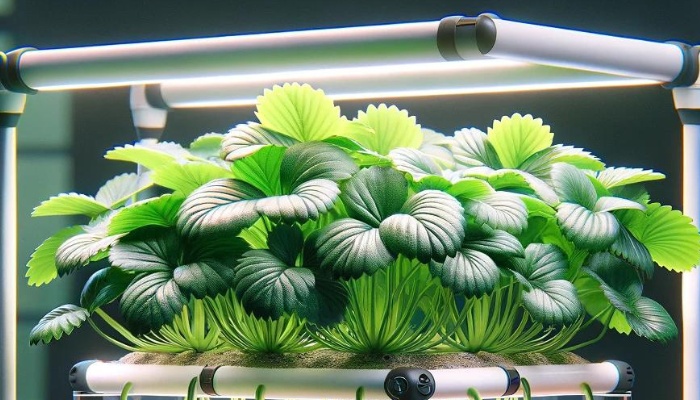Welcome to the lush and promising world of hydroponic strawberries, a garden trend that’s capturing the hearts of home growers everywhere.
Imagine nurturing a bountiful harvest of plump, sweet strawberries in the comfort of your own space, free from the constraints of seasons and soil.
Whether you have a sprawling backyard or a modest living room setup, we’ll guide you through setting up your own hydroponic system, selecting the right varieties, and providing your plants with the perfect balance of nutrients and care.
Choosing Your System
Selecting the right hydroponic system is critical for optimizing your strawberry yield and ensuring efficient nutrient delivery.
When you’re choosing your system, you need to consider both space requirements and water quality as these factors can significantly impact your strawberries’ growth and health.
For starters, assess your available space. Hydroponic systems range from vertical towers to horizontal NFT (Nutrient Film Technique) channels, each with distinct space needs.
Vertical systems are ideal if you’re tight on space, allowing you to grow upwards. In contrast, horizontal systems, while requiring more floor space, often provide easier access to your plants for maintenance and harvesting.
Water quality is another critical consideration. Strawberries are sensitive to the concentration of nutrients and the pH level of the water they’re grown in. You’ll need a system that allows for precise control over these variables.
Recirculating systems, like the Dutch bucket or the NFT, enable you to adjust and monitor nutrient levels and pH more accurately, ensuring your strawberries receive the optimal conditions they need to thrive.
Choosing the right system and considering space requirements and water quality sets the foundation for a successful hydroponic strawberry operation.
Selecting Strawberry Varieties
When choosing strawberry varieties for your hydroponic system, consider factors such as yield, taste, and disease resistance to ensure optimal performance and fruit quality.
Different varieties bring diverse characteristics to the table; thus, understanding these traits can significantly impact your hydroponic venture’s success.
Focusing on disease resistance is vital. While hydroponic systems reduce some soil-borne diseases, they can still harbor pathogens that affect strawberries.
Varieties with built-in resistance to common fungi and viruses will save you a lot of headaches and reduce the need for chemical interventions.
Research the prevalent diseases in your area and select varieties known to withstand those conditions.
Secondly, consider pollination methods. Strawberries can be self-pollinating or require cross-pollination. Knowing your chosen variety’s pollination requirement is essential as it influences how you’ll manage your hydroponic setup.
For self-pollinating varieties, you won’t need to worry about introducing pollinators or additional plants for cross-pollination.
However, for varieties requiring cross-pollination, you’ll need to ensure compatible plants are grown together or provide manual pollination assistance.
Nutrient Solution Basics
Your strawberries’ growth hinges on the precise formulation of the nutrient solution they’re fed.
Achieving the perfect balance involves careful attention to pH management and water quality, two pivotal factors in the successful cultivation of hydroponic strawberries.
| Key Element | Why It’s Important |
|---|---|
| pH level | Ensures nutrient availability and uptake |
| Water quality | Prevents nutrient lockout and toxicity |
| Nutrient balance | Promotes healthy growth and fruit production |
| Electrical conductivity (EC) | Measures nutrient concentration, guiding adjustments. |
Management of pH is vital; strawberries thrive in a slightly acidic environment, typically between 5.5 and 6.5. This range maximizes nutrient absorption, critical for their development and sweetness.
Regular testing and adjustments ensure the solution stays within this ideal pH window.
Water quality can’t be overlooked. High levels of contaminants or heavy metals in your water can hinder nutrient uptake, leading to poor growth or even plant death.
Using filtered or reverse osmosis water ensures your strawberries receive only what they need, nothing less and nothing more.
Light and Temperature Control
To optimize your hydroponic strawberries’ growth, you must manage light exposure and temperature settings with precision. The right light spectrum plays an important role in maximizing fruit production and enhancing flavor.
Strawberries thrive under full-spectrum LEDs, which mimic sunlight, promoting healthy vegetative growth and fruitful flowering.
Aim for 8 to 12 hours of light daily, ensuring your plants receive the energy they need without the stress of overexposure.
Temperature fluctuations can significantly impact your strawberries’ health and yield. Ideal temperatures range between 65°F and 75°F during the day, dipping slightly to 55°F to 65°F at night.
This mimics the natural diurnal temperature variation, encouraging robust growth and optimal fruit development. Monitor your grow space vigilantly, utilizing fans or heaters to stabilize the environment.
Excessive heat can lead to poor fruit quality and reduced yields while cool conditions might slow plant growth and delay fruiting.
In managing these parameters, you’re creating an environment that closely imitates nature, optimizing conditions for your hydroponic strawberries to thrive.
Harvesting and Maintenance
Harvesting your hydroponic strawberries at the peak of ripeness ensures the highest quality and flavor, requiring careful attention to timing and technique.
Monitor your berries closely, as hydroponic strawberries tend to ripen more uniformly than their soil-grown counterparts. Gently twist the fruit, allowing it to detach without damaging the plant or the berry.
Remember that strawberries don’t ripen further once picked, so timing is important.
Regularly inspect your plants for signs of pests, and manage infestations promptly using environmentally friendly methods, such as introducing beneficial insects or applying organic pesticides.
Remove dead or diseased leaves and runners that don’t produce fruit, directing energy toward berry production.
This not only promotes air circulation and reduces the risk of fungal diseases but also ensures the plant’s resources are focused on developing succulent, ripe strawberries.

